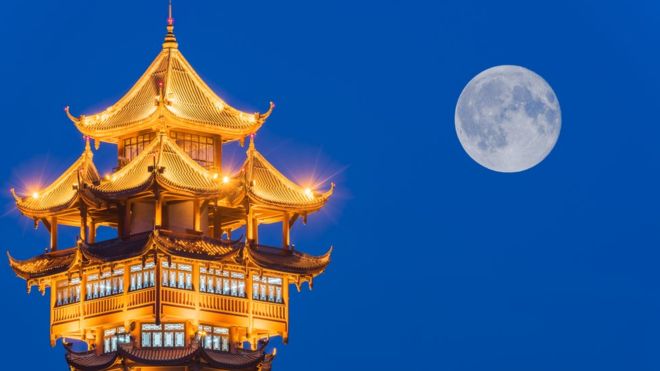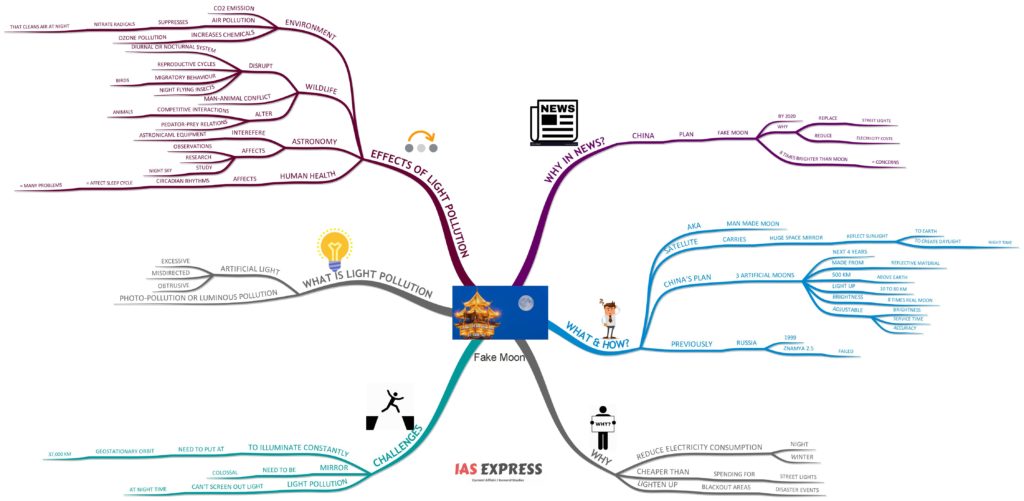Fake Moon – Lighting Up the Night Sky

From Current Affairs Notes for UPSC » Editorials & In-depths » This topic
IAS EXPRESS Vs UPSC Prelims 2024: 85+ questions reflected
Recently a private company in Chengdu, China has announced its plans to put a “fake moon” or illumination satellite into space by 2020 in order to brighten the night sky replacing streetlights and lower electricity costs. The fake moon will be 8 eight times brighter than the moon which is a cause of concern.
Fake Moon – What and How?
- Fake moon or man-made moon is a satellite that carries a huge space mirror that can reflect sunlight to the earth in order to create daylight at night time.
- China’s plan is to send 3 artificial moons or illuminating satellites into space in the next four years.
- The moons are made from a reflective material like a mirror.
- They will be placed at 500 km above the earth (real moon = 3,80,000 km)
- They will light up an area with a diameter of 10 to 80 km.
- The illuminating satellite would give a dusk-like glow with brightness 8 times that of real moon.
- The satellite’s brightness, service time and accuracy of the lighting are all adjustable.
- The idea of the artificial moon emerged from a French artist who imagined hanging a necklace made of a mirror in the sky to light up the streets of Paris at night.
- It has to be noted that, this is not the first time a space mirror to create daylight at night has actually been tried before. In 1999, Russia tried to launch a 25-meter “space mirror” called Znamya 2.5 which briefly beamed a spot of light about 5 km in diameter to Earth. The light marched across Europe at 8 km/hr, before the satellite burned up on re-entry.
Why fake moon? (Benefits)
- The Three artificial moons would operate alternately in order to reduce electricity consumption considerably especially during night and winter season (cloudy = less sunlight = more artificial lights = more electricity consumption).
- Putting a fake moon in space could actually end up being cheaper than spending for street lights.
- It could also lighten up blackout areas in any natural disaster events like Earthquake, floods etc.
What are the challenges?
- Chinese’ plan to put the satellite at 500 km above the earth is not viable because to illuminate the city for a fixed period, the satellite has to stay at its position constantly, which is possible only at the geostationary orbit which is about 37,000 km from earth.
- Another challenge is that, when lighting up an area, say for about 10 km, even if they miss by one 100th of a degree, then the light will be pointing at another place. And to have any impact from that distance (500 km), the mirror would have to be really colossal.
Fake Moon and Light Pollution
- Fake moons will cause much more light pollution by considerably increasing the night-time brightness of an already light-polluted city (Chengdu) creating problems for people who are unable to screen out the unwanted light.
- It would disrupt the night cycle of nature and this could possibly affect animals especially the nocturnal ones.
What is Light pollution?
- It is defined as an excessive, misdirected, or obtrusive artificial light in the environment.
- It is also called photo-pollution or luminous pollution.
What are the effects of Light pollution?
Environment
- High night-time lighting releases more than 12 million tons of Carbon Dioxide (CO2) = global warming.
- It will enhance air pollution by means of suppressing a naturally forming Nitrate Radical that cleans the air at night as it prevents ground-level ozone formation.
- Artificial light also enhances the chemicals for ozone pollution by 5 percent.
Wildlife
- Lights can attract or repel insects and animals. Light pollution will disrupt animals that function on a diurnal or nocturnal system. This can cause danger to the entire species.
- It will attract unwanted species into human areas.
- It affects the reproductive cycles of certain animals.
- It disrupts the migration of birds that navigate using the stars.
- It disorients night-flying insects.
- It will alter the competitive interactions of animals.
- It will alter predator-prey relations.
Astronomy
- Light spill and sky glow interfere with astronomical equipment = difficult to observe faint celestial bodies even with the help of a telescope.
- Furthermore, it affects the observations, research as well as the scientific study of the night sky.
Human health
- It affects the circadian rhythms that regulate physiological activities like brainwave patterns, hormone, and cell regulation.
- Disrupting this rhythm can lead to health problems like sleep disorders, anxiety, depression, diabetes, cancer, cardiovascular disease, immunological disorders, and obesity.
- Artificial light disrupts the circadian rhythm by means of affecting the production of the hormone named Melatonin that regulates the sleep and wake cycle. Melatonin is activated by darkness and suppressed by light.
Way ahead
The idea of a fake moon is a revolutionary concept and it could significantly cut the energy costs and in result mitigate climate change because most electricity is generated from thermal power plants which emit CO2 and other harmful chemicals. However, the threat of light pollution and its ill effects on the environment, wildlife, and human health cannot be ignored and should be studied deeply and find the right solution or alternatives. Therefore, any such initiatives like fake moon should not be aimed at benefiting mankind at the cost of ecosystem or sustainability.
Practice Question
Fake moon is considered to be beneficial for the mankind as well as a cause of concern. Discuss the reasons.
If you like this post, please share your feedback in the comments section below so that we will upload more posts like this.


